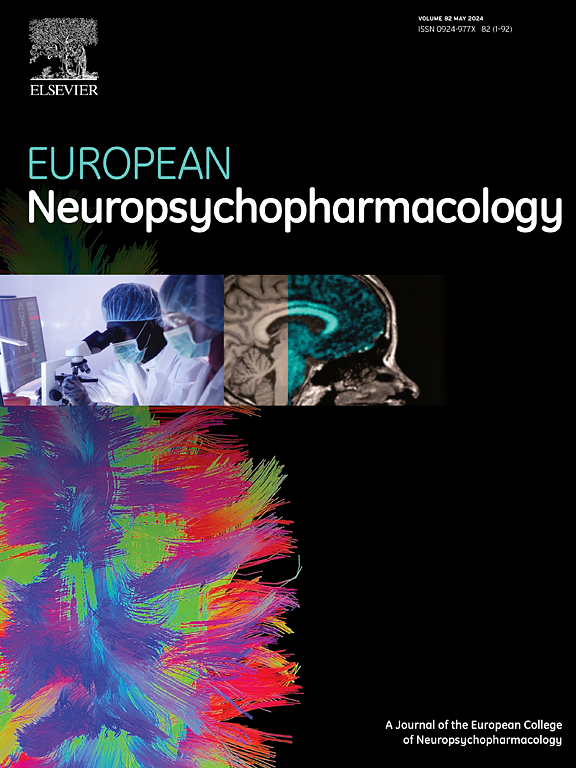双相情感障碍的处方序列——一项丹麦全国范围内基于登记的研究,对19927名个体进行了10年的跟踪研究
IF 6.1
2区 医学
Q1 CLINICAL NEUROLOGY
引用次数: 0
摘要
循证使用药物干预双相情感障碍是至关重要的临床重要性。我们的目的是在首次诊断为双相情感障碍的大量患者中发现处方序列。使用丹麦全国登记,我们确定了2001年1月1日至2016年12月31日期间首次住院诊断为双相情感障碍的个体。检索诊断前5年至诊断后5年的诉讼、抗惊厥药、抗精神病药和抗抑郁药处方。采用描述性统计、日暴图和Cox比例风险模型对数据进行分析。整个研究人群包括19,927人。诊断前,抗抑郁药是主要处方组(46.9%为第一药)。诊断后,观察到情绪稳定策略的主要趋势。尽管只有18.7%的患者接受了锂的首次处方。在疾病阶段分层的分析中,锂更频繁地作为抑郁症后的第一种药物,而不是轻躁狂/躁狂后的第一种药物,其中10- 15%的病例将抗抑郁药作为第一种药物。治疗序列是高度异质性的(在调查的19,927个个体中有2,459个不同的序列)。总的来说,锂似乎具有最高的治疗转移风险。我们得出结论,根据国家和国际指导方针,双相情感障碍的诊断导致对情绪稳定药物治疗策略的相关改变。然而,锂的使用仍然不足;抗抑郁药的使用可能过于频繁,治疗顺序高度不均匀,没有根据疾病阶段进行调整。这些结果指出了优化双相情感障碍的现实世界药理学管理的潜力。本文章由计算机程序翻译,如有差异,请以英文原文为准。
Prescription sequences in bipolar disorder – A nationwide Danish register-based study of 19,927 individuals followed for 10 years
Evidence-based use of pharmacological interventions in bipolar disorder is of paramount clinical importance. We aimed to uncover precription sequences in a large cohort of patients from the first diagnosis of bipolar disorder. Using Danish nationwide registers, we identified individuals with a first-time hospital diagnosis of bipolar disorder between January 1st, 2001, and December 31st, 2016. Redemeed prescriptions of litihum, anticonvulsants, antipsychotics, and antidepressants from five years before to five years after diagnosis were retreived. The data were analysed with descriptive statistics, sunburst plots, and Cox proportioal hazard models. The full study population consisted of 19,927 individuals. Before diagnosis, antidepressants were the predominantly prescribed group (46.9 % as first drug). After diagnosis, a major trend towards mood stabilising strategies was observed. although only 18.7 % received lithiumas first prescription. In analyses stratified for illness phase, lithium was more frequently prescribed as first drug after depression than after hypomania/mania, in which antidepressants were used as first drug in 10-15 % of the cases. Treatment sequences were highly heterogeneous (2,459 distinct sequences for the 19,927 individuals under investigation). Lithium appeared to carry the overall highest risk of treatment shift. We conclude that in accordance with national and international guidelines, a diagnosis of bipolar disorder leads to a relevant change of treatment strategy towards mood stabilising drugs. However, lithium continues to be underused;antidepressants probably used too frequently, and treatment sequences are highly heterogeneous and not adjusted according to illness phase. These results point to a potential for optimising the real-world pharmacological management of bipolar disorder.
求助全文
通过发布文献求助,成功后即可免费获取论文全文。
去求助
来源期刊

European Neuropsychopharmacology
医学-精神病学
CiteScore
10.30
自引率
5.40%
发文量
730
审稿时长
41 days
期刊介绍:
European Neuropsychopharmacology is the official publication of the European College of Neuropsychopharmacology (ECNP). In accordance with the mission of the College, the journal focuses on clinical and basic science contributions that advance our understanding of brain function and human behaviour and enable translation into improved treatments and enhanced public health impact in psychiatry. Recent years have been characterized by exciting advances in basic knowledge and available experimental techniques in neuroscience and genomics. However, clinical translation of these findings has not been as rapid. The journal aims to narrow this gap by promoting findings that are expected to have a major impact on both our understanding of the biological bases of mental disorders and the development and improvement of treatments, ideally paving the way for prevention and recovery.
 求助内容:
求助内容: 应助结果提醒方式:
应助结果提醒方式:


